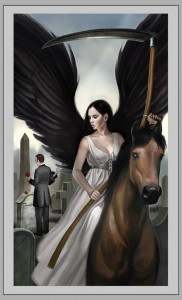The Death Card
Tarot readers spend a lot of energy explaining that “Death doesn’t actually mean physical death, mostly; it usually means transformation.” And of course, I agree with that. And yet, I don’t completely agree with it.
It strikes me as ironic that we are so afraid to predict death when, in truth, it is the only prediction we can make with absolute certainty that it will come true…for we all die.
Handling the news of death, if one sees that in the cards, is a very delicate subject…one that takes much deeper consideration and experience than can be conveyed in a short blog article.
Metaphorically-speaking, however, we can talk of Death as change and transformation. But also, it is a card of endings. Before the transformation occurs, something has to end. We tend to skate over this fact and focus more on the “positive” outcome. This can be dangerous and misleading. Because any sort of loss requires healthy mourning before the loss can be accepted and we can move on. Also, by pointing out the butterfly coming out of the cocoon, we diminish and downplay the real pain involved in metamorphosing from an earth-bound creature to an air-bourn one. People who come to a reading a probably looking for validation and empathy for the real pain they are feeling.
This is one reason I love the Death card from the Legacy of the Divine. It acknowledges the decomposition that occurs before the transformation. In fact, the rich, lush images are one reason so many people love this deck. What are your favorite Death cards and why?
I also like the Death card from my forthcoming Steampunk Tarot. I wanted to honor the sadness that accompanies loss.










In my opinion the challenge of the Death card is two-fold. First, the very name conjures images of finality and termination by clients, and second, the influence of TV, movies, and novels that usually misinterpret the card as always indicating a physical death. As a result, in order to get clients over seeing D*E*A*T*H instead of listening to the reading, I say: “Oh, good. I’m going to try to say this with one breath. [I take a deep and loud breath, then say quickly] Whenever the Death card comes up I have to explain it because if you’ve ever seen a movie where the Death card comes up somebody immediately gets killed with a knife in the back or a shot to the head. In reality, it actually means [I say the following 3 words slowly] positive, evolutionary change. It’s death only in the sense that a caterpillar has to ‘die’ so a butterfly can live.” I then exhale any remaining breath loudly. In my readings this gets the point across, releases the emotional impact and tension from the name and image on the card, and opens the client for more information.
As you point out, the card, however, does on some occasions indicate actual, physical death. Thankfully, this only happened to me one time. Once, while giving readings at a psychic fair in San Diego, I gave a reading to an elderly woman who was suffering horribly with financial, physical, and emotional pain. Normally, I interpret cards as they are revealed. In this case the reading was so negative, culminating with the Death card, that I had to look at all the cards before giving an interpretation. Without just blurting out my interpretation that her physical death was immanent, I focused on how all of her issues would be resolved, she wouldn’t have to worry about finances, her many aches and pains would be overcome, and she would move at the exact speed she needed to travel on her personal spiritual path. She looked me in the eye at the end of the reading and said, “That you very much. That’s exactly what I thought. I just wanted to make sure.” I was so shook up that I had to take a break for over an hour. The lovely woman had been a regular at the psychic fairs, but after that day, she was never seen at another fair.
The Spiral Tarot has my favorite Death card. It shows a reaper in a tattered boat casting lines to the souls flailing in the black waters around him. There are some grasping for the lines and others that seem too afraid to reach out. Behind the reaper is a glowing white figure rising to the heavens giving the impression that Death is the salvation and catalyst for this transformation from drowning fear to rising peace. However, it takes reaching out and grabbing hold of something that is pretty scary to make that transition. In order to make the evolutionary changes in our lives, we need to embrace the scary, unknown possibilities that are in front of us.
As folks that know me, know the Death card is often one of the first cards I look at in a deck before deciding whether to purchase it or not. I’ve been known to say that the death card is not ‘death-y’ enough.
As an example of a ‘Not Death-y’ tarot card is in Tarot of Dreams. It doesn’t capture the images of death enough for me. The shed snakeskin in the image is often difficult to see or understand.
I have to say one of my favorite Death cards can be found in James Ricklef’s Tarot of the Masters. The simple winter graveyard scene captures so much in it’s simplicity. I also like the death card in the Robin Wood Tarot, again simple, and not too over the top. I find that simpler images allow for more intuition to flow, and do not distract the Seeker from other elements in the reading.
Great article, Barbara. 🙂
My favorite Death cards is from Favole Tarot deck. Because its Death card potrays a woman floating (probably drowned) in a lake (unconscious mind/undeworld portal). Is it her body? Is it her spirit? This is earthly and ethereal at the same time. Like the Death herself: she wanders between the worlds.
Thanks Barbara for saying what I’ve been saying for years, “Before the transformation occurs, something has to end. [Readers] tend to skate over this fact and focus more on the “positive” outcome.”
Yes, Death is a card of transformation – as in, life now goes one without that which once was (no, that Caterpillar doesn’t die, the form the Caterpillar took dies – that’s called continuity of existence, the soul that remains the same – that’s transformation, not Death). Death is the ending of something and must be acknowledged as permanently gone. And totally gone. The “transformation” so many (readers) want to focus on instead is in ignorance. Like I said, what “transforms” is that which is still alive beyond that which has died (the mourners, the pontiff, the innocence as in the Waite version) – this is why my favorite version is the Thoth Tarot’s Death card. It makes no bones about it. It’s putrid, rotten, painful. The hint of the transformation is there only in myth, as a phoenix relative to the Scorpio.
My favourite Death card has to be the one from the Rabbit Tarot.
http://www.nakisha.com/rabbit_tarot/the_rabbit_tarot.htm
Not because it is unbearably cute, (which it is), but because there is a sense of peace about the image. Death’s embrace is gentle and welcoming. There is a sense of coming home, of final rest. There are no bones, no weeping, just peace. I would prefer to think of Death in this way – we can’t avoid it, so may as well make peace with it 🙂
Barbara, I agree with you. People tend to focus more on the positive aspect, and not the real meaning behind the Death card. I cannot wait for your forthcoming Steampunk cards. I love the image of Death that you use. And yes, all too often we have to explain to people we are reading to that the Death card doesn’t mean actual death, but a symbolic death. But we do have to look at the darker aspect of the card, to deal with the darker aspect before we can be the butterfly that comes out of the cocoon.
And Donald, I agree with you that the media gives the Death card a bad reputation. I feel for you having read for that poor woman.